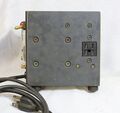1216-A: Difference between revisions
No edit summary |
No edit summary |
||
| Line 20: | Line 20: | ||
}} | }} | ||
The '''General Radio 1216-A Unit IF Amplifier''' was introduced in 1954 Catalog N and remained available through Catalog T 1968. | The '''General Radio 1216-A Unit IF Amplifier''' was introduced in 1954 Catalog N and remained available through Catalog T 1968. | ||
The Type 1216-A is an high gain amplifier operating at a fixed frequency of 30 MHz with a bandwidth of 0.7 MHZ. Combined with a unit oscillator and mixer forms what General Radio calls a DNT detector. A DNT Detector in its simplest form is radio receiver whose frequency range is determined by the selected unit oscillator. The 1216-A is equipped with a meter for signal strength measurement using its built in attenuator. The meter can switched to monitor input to the amplifier. An AVC function located on the attenuator switch is advantageous when used in the null detector role. The 1216-A contains its own power supply and connection for powering the external unit oscillator. Front panel binding posts provide demodulated output of the signal. The recommended mixer for DNT applications is the [[874-MR]] with an upper frequency limit 5 GHz. | |||
==Specifications== | ==Specifications== | ||
Revision as of 04:32, 3 April 2024
The General Radio 1216-A Unit IF Amplifier was introduced in 1954 Catalog N and remained available through Catalog T 1968.
The Type 1216-A is an high gain amplifier operating at a fixed frequency of 30 MHz with a bandwidth of 0.7 MHZ. Combined with a unit oscillator and mixer forms what General Radio calls a DNT detector. A DNT Detector in its simplest form is radio receiver whose frequency range is determined by the selected unit oscillator. The 1216-A is equipped with a meter for signal strength measurement using its built in attenuator. The meter can switched to monitor input to the amplifier. An AVC function located on the attenuator switch is advantageous when used in the null detector role. The 1216-A contains its own power supply and connection for powering the external unit oscillator. Front panel binding posts provide demodulated output of the signal. The recommended mixer for DNT applications is the 874-MR with an upper frequency limit 5 GHz.
Specifications
- Center Frequency: 30 MHz
- Bandwidth: 0.7 MHz at 3 dB down; 9.5 MHz at 60 dB down
- Attenuator Range: 0 to 70 dB in 10 dB steps, a single 3 dB step is also provided
- Sensitivity: Less than 2 μV input from a 400 Ω source required for a 1% meter deflection (above noise). Less than 50 μV input from a 400 Ω source required for full-scale meter deflection. Input voltages referred to are open circuit source voltages.








